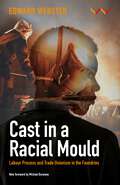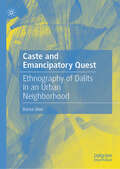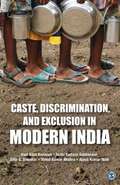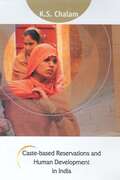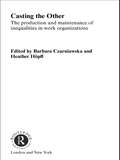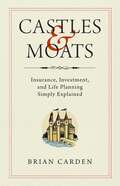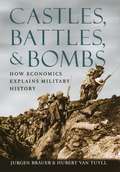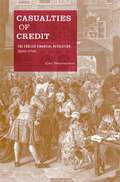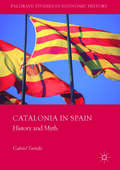- Table View
- List View
Casper Sleep Inc.: Marketing the "One Perfect Mattress for Everyone"
by Robert J. Dolan"A Warby Parker of mattresses? Somebody is going to do it. Why not us?" This was the topic of a conversation begun in spring 2013 among Gabe Flateman, Philip Krim, Neil Parikh, and T. Luke Sherwin. The four met as members of a New York City venture accelerator program. All admired Warby Parker's success in delivering on the promise of "designer eyewear at revolutionary prices," via a direct-to-consumer sales model. "Big Mattress," their term for the current manufacturer / retailer system, featured not only high prices, but also, as they would describe to many in the days ahead, "one of the worst buying experiences in the world."
Cast in a Racial Mould: Labour Process and Trade Unionism in the Foundries
by Edward Webster Michael BurawoyFirst published by Ravan Press in 1985, Cast in a Racial Mould was a pioneering book. It is now republished by Wits University Press with a new foreword by Michael Burawoy and with support from the National Institute for the Humanities and Social Sciences.Entering what Marx called the hidden abode of capitalism; the labour process; this book analyzes the nature of work and worker resistance in the metal industry which lies at the core of South Africa manufacturing industry. In an introductory chapter Webster points out that most studies of the labour process have neglected worker resistance. He challenges Braverman depiction of mass production as a juggernaut which inherently imposes progressively tighter controls on workers, and points to two forms of worker resistance which have been important in the history of South Africa foundries.Discussing the first of these in Part I, he shows how resistance to deskilling on the part of white craft moulders gave rise to a distinctive racial hierarchy of control in the foundries. Using race as a last line of defence against machinofacture assault on their craft privileges, the white moulders effectively became supervisors of semi-skilled black labour;The collapse of this form of control was precipitated by the rise, in a South African foundry context, of the second form of resistance ; increasingly confident bargaining by black semi-skilled workers in the wake of mechanization and the emergence of independent black unions. This is the focus of Parts II and III of the book. The onset of popular struggle in the townships from 1976 onwards forced the state, through a process that began with the Wiehahn and Riekert commissions, to embark on an attempt to incorporate black unions in a deracialized industrial relations system. Webster analyzes the interplay between the transformation of the labour process and the crisis in the system of racial capitalism as a whole to show how worker organizations, in resisting the state incorporative strategy, have begun to develop a working class.
Cast of Characters: Who's Who in Project Management
by Harvard Business Review PressGetting the right people on board is an essential part of a successful project plan. This chapter offers guidelines ranging from choosing the most effective project manager to choosing the right team members. This cast of characters is responsible for the achievement of a particular goal, so choosing members should ideally be determined by who is best suited to accomplish the work.
Caste and Emancipatory Quest: Ethnography of Dalits in an Urban Neighborhood
by Rama DeviThe book unravels the entangled relationship between ascriptive identity (caste) and space (urban) and how this interaction (re)moulds urban stratification. Urban rather represents a liminal space while offering promising opportunities to aspire and achieve upward mobility, it presents structural constraints frustrating the march of Dalits to claim desired mobility. Through descriptive and nuanced accounts of various aspects of Dalit lives in urban, it foregrounds how caste permeates everyday city life. The book debunks the mirage of urban castelessness.
Caste, Class, and Capital
by Kanta MuraliFor millions of poor people in the developing world, economic growth offers prospects for improved well-being. But what are the political and social conditions conducive to growth-oriented policies in poor democracies? This book addresses this highly consequential question by focusing on a specific empirical puzzle - policy variation across Indian states in the competition for private industrial investment, a phenomenon that came to the fore after the country adopted market reforms in 1991. Through the analysis of investment policies, this book offers a novel explanation, which links social identity, class, and economic policy outcomes. Its main findings highlight a link between pro-business policies and exclusionary political trends in India's high growth phase, and offer a sobering perspective on the current model of growth in the country. It adds to our understanding of Indian political economy as well as to the dynamics of economic development in poor democracies.
Caste, Discrimination, and Exclusion in Modern India
by Vani Kant Borooah Vinod Kumar Mishra Ajaya Kumar Naik Dilip G Diwakar Nidhi S SabharwalA comprehensive assessment of the broad issues that underpin social exclusion in India This book posits the Scheduled Castes (SCs) and Scheduled Tribes (STs) vis-à-vis their upper-caste Hindu peers and establishes how caste is a lived reality in everyday life in modern India. It explores areas where caste and religious exclusion are most visible, such as human development, inequality, poverty, educational attainments, child malnutrition, health, employment, wages, gender, and access to public goods. With an in- depth theoretical foundation and empirical analysis, it establishes that in each of these sectors, the performance of upper-caste Hindu households is far better compared to that from the SC, ST, and Muslim households.
Caste-Based Reservations and Human Development in India
by K S ChalamCaste-based reservations have existed in India for more than a century. Initially introduced by the British to bring equality of opportunity in education, reservation was later extended to other sectors of the development process to overcome the problem of economic inequalities attributed to caste. Even today, concepts like affirmative action and quotas are being debated to justify reservation. This book provides a comprehensive assessment of the impact of caste-based reservation on human development in India, taking into consideration the time series data. The book also analyses the impact of caste-based reservations on the target groups, as well as on major human development indices. An alternative strategy of applying the democratic principle of caste-based reservation is also discussed.
Casting the Other: The Production and Maintenance of Inequalities in Work Organizations (Routledge Studies in Management, Organizations and Society)
by Barbara Czarniawska Heather HōpflCasting the Other: Maintaining Gender Inequalities in the Workplace focuses on the production and maintenance of gender inequalities in organizations. By emphasizing 'difference' as something to be managed many organizations institute the 'problem of difference', and while orgainzations pay lip-service to ideas of equality, their day-to-day practices may be unchanged and unchallenged. Discrimination of various groups such as women, immigrants and older people continues and its dynamics remain unclear, largely because of the difficulties of studying it in the field. Additionally, various programs aimed at removing inequality, such as gender equality of managing diversity programs, may actually promote it by making differences visible and stabilizing them. Management, under these circumstances, comes to refer to the management of appearances which take the place of more radical acts to change the 'status quo'.
Castles and Moats: Insurance, Investment, and Life Planning Simply Explained
by Brian CardenIn Castles and Moats, Brian Carden simply explains insurance and investing, unpacks all the different options, and helps us chart a course to the financial future we&’ve always dreamed of and worked so hard to obtain.Americans are confused about managing their finances, insurance needs, and overall life planning. In the past, money wasn&’t the do-it-yourself project it has become today. Instead, consumers had insurance and financial professionals to help them make prudent decisions. The point-and-click, self-serve nature of the Information Age has robbed us of the personalized face-to-face relationships that once led us into good financial decisions. Today, we&’re drowning in information . . . but we&’re starving for unbiased education without a sales pitch attached. We need a &“professional explainer&” to come alongside us, unpack all the different options, and help us chart a course to the financial future we&’ve always dreamed of and worked so hard to obtain. In Castles and Moats, Brian Carden is that &“explainer.&” He helps you understand, prioritize, organize, strategize, and stress-test each financial product or strategy to help you create a more favorable outcome. You&’ll learn how to avoid buying products or strategies that might seem good when you buy them, only to find out about the pitfalls later in your life. By recapturing those lost dollars and redeploying them towards other, more tailored solutions, you&’ll increase your chance of financial independence with more predictable outcomes. Unpacking all the ins and outs of insurance, planning, and investment strategies, Brian provides an unbiased, practical, and easy-to-understand guide for you to make better, more informed decisions. In Castles and Moats, he equips you to build your glimmering castle of wealth and surround it with a moat of protection.
Castles, Battles, & Bombs: How Economics Explains Military History
by Jurgen Brauer Hubert van TuyllCastles, Battles, and Bombs reconsiders key episodes of military history from the point of view of economics—with dramatically insightful results. For example, when looked at as a question of sheer cost, the building of castles in the High Middle Ages seems almost inevitable: though stunningly expensive, a strong castle was far cheaper to maintain than a standing army. The authors also reexamine the strategic bombing of Germany in World War II and provide new insights into France’s decision to develop nuclear weapons. Drawing on these examples and more, Brauer and Van Tuyll suggest lessons for today’s military, from counterterrorist strategy and military manpower planning to the use of private military companies in Afghanistan and Iraq."In bringing economics into assessments of military history, [the authors] also bring illumination. . . . [The authors] turn their interdisciplinary lens on the mercenary arrangements of Renaissance Italy; the wars of Marlborough, Frederick the Great, and Napoleon; Grant's campaigns in the Civil War; and the strategic bombings of World War II. The results are invariably stimulating."—Martin Walker, Wilson Quarterly"This study is serious, creative, important. As an economist I am happy to see economics so professionally applied to illuminate major decisions in the history of warfare."—Thomas C. Schelling, Winner of the 2005 Nobel Prize in Economics
Castles, Battles, and Bombs: How Economics Explains Military History
by Jurgen Brauer Hubert Van TuyllCastronics, LLC
by Richard S. Ruback Royce YudkoffPatrick Dickinson (HBS '09) and Michael Weiner (MIT's Sloan '07) acquired Castronics, a firm that specialized in threading pipe used in the oil and natural gas industry, at the end of 2009. The partners overcame significant hurdles during the first two years of ownership, which included the loss of nearly half of their workforce, the threatened entry of a formidable competitor into their market, and limited production capacity. In spite of these challenges and many other day-to-day obstacles, by the summer of 2011, the company successfully tripled production and EBITDA and the partners were deciding whether or not to sell the company.
Casualties of Credit: The English Financial Revolution, 1620-1720
by Carl WennerlindModern credit, developed during the financial revolution of 1620¬–1720, laid the foundation for England’s political, military, and economic dominance in the eighteenth century. Possessed of a generally circulating credit currency, a modern national debt, and sophisticated financial markets, England developed a fiscal-military state that instilled fear in its foes and facilitated the first industrial revolution. Yet a number of casualties followed in the wake of this new system of credit. Not only was it precarious and prone to accidents, but it depended on trust, public opinion, and ultimately violence. Carl Wennerlind reconstructs the intellectual context within which the financial revolution was conceived. He traces how the discourse on credit evolved and responded to the Glorious Revolution, the Scientific Revolution, the founding of the Bank of England, the Great Recoinage, armed conflicts with Louis XIV, the Whig-Tory party wars, the formation of the public sphere, and England’s expanded role in the slave trade. Debates about credit engaged some of London’s most prominent turn-of-the-century intellectuals, including Daniel Defoe, John Locke, Isaac Newton, Jonathan Swift and Christopher Wren. Wennerlind guides us through these conversations, toward an understanding of how contemporaries viewed the precariousness of credit and the role of violence—war, enslavement, and executions—in the safeguarding of trust.
Cat Fight in the Pet Food Industry (A)
by David J. Collis Toby StuartDescribes the pet food industry in the mid-eighties prior to the breakout of a major competitive battle as manufacturers fight for share. Illustrates how when there are benefits to play in multiple markets, competitors will take action in one market to preserve their position in other markets. An example of multimarket competitive interaction. Covers competitor analysis and prediction, and economies of scope.
Cat Fight in the Pet Food Industry (B)
by David J. Collis Toby StuartDescribes the contest for the takeover of Anderson Clayton as industry players compete for one of the seven major dog food makers.
Cat Fight in the Pet Food Industry (C)
by David J. Collis Toby StuartDescribes significant developments in the pet food industry in 1987 and 1988, focusing on the competitive interactions among the industry's major players.
Cat Fight in the Pet Food Industry (D)
by David J. Collis Toby StuartDescribes important developments in the pet food industry in 1989, 1990, and 1991, focusing on competitive dynamics among the industry's major players.
Cat Is Out of the Bag: KANA and the Layoff Gone Awry (A)
by Leslie A. Perlow David L. AgerVicki Amon-Higa, vice president of KANA, a publicly traded, midsize development company, was working with Bryan Kettle, KANA's CFO, to plan a layoff in which KANA would reduce the size of its workforce by nearly 40%. Despite the best of intentions, news of the layoff leaked before the planned announcement. The situation quickly deteriorated as a series of irate managers called Amon-Higa, demanding to know why they weren't aware of the layoff and asking her how to handle the situation. She must quickly assess the situation, figure out what went wrong, and decide how to manage each of the company's stakeholders, including Chuck Bay, KANA's CEO.
Cat Is Out of the Bag: KANA and the Layoff Gone Awry (B)
by Leslie A. Perlow David L. AgerSupplements the (A) case.
Cat Is Out of the Bag: KANA and the Layoff Gone Awry (C)
by Leslie A. Perlow David L. AgerSupplements the (A) case.
Catalan Leather Industry
by Michael J. Enright Eduardo Ballarin Maria Del Mar Prats Maria Dolores RodriguezAntoni Subira, the Minister of Industry in Catalonia, Spain, must decide whether to impose strict European Union environmental guidelines on the local leather industry. Failure to impose new regulations would result in substantial fines. Imposition, on the other hand, could lead to a further decline in an industry already buffeted by foreign competition.
Catalant's Operating System for the Future of Work
by William R. Kerr Christopher Stanton James Palano Kendall SmithThis case touches on the topics of project-based work, agile methodology, and skill and talent management through Catalant's evolution as a company. Catalant's journey to becoming a software platform and talent marketplace provides context for students to explore new models of work and ways companies are mobilizing talent internal and external to their organization. This case urges students to contemplate how these considerations might shape the critical decisions business leaders will need to make about how to manage their organizations and use their resources to capitalize on their own vision for the future. This case also provides valuable lessons for technology entrepreneurship, introduces students to important gig economy concepts, and asks students to consider the unique challenges facing companies like Catalant that are selling a gig platform as part of their product or service.
Catalant: The Future of Work?
by Christine Snively Thomas R. Eisenmann Jeffrey RayportCatalant, founded in 2013 as an online marketplace where MBAs could bid on consulting projects posted by small- to medium-sized businesses, had expanded by 2016 to provide Fortune 1000 companies with access to over 35,000 independent experts. The founders envisioned extending their matching solutions to help enterprises staff projects with a mix of current employees and external experts, hypothesizing that the "future of work" would involve more flexible employment arrangements. They debated how much to invest in new functionality versus improving their existing marketplace, and how to pitch their evolving strategic vision to investors.
Catalina in the Digital Age
by Robert J. Dolan Uma R. KarmarkarCatalina in the Digital Age considers how a company with a dominant market position should evolve its established product lines given the rise of novel digital technologies. Since its founding in 1983, Catalina had enjoyed a distinct position in the world of consumer promotions. Serving both retailers and consumer packaged goods (CPG) firms, the company's core business was distributing "cents off" coupons to shoppers via proprietary printers at checkout registers. This position allowed them to offer coupons that were "personalized" to the purchases that had just been made in the current transaction. The advent of shopper loyalty cards in the 1990s allowed them to expand that targeting to take shopper's history of purchase into account as well. In many ways, they were a successful "big data" firm well before the term became an industry buzzword.
Catalonia in Spain: History and Myth (Palgrave Studies in Economic History)
by Gabriel TortellaThis book explores the complex history of Catalonia in relation to Spain from an economic and political perspective. It begins in the Middle Ages and ends in the present day, analysing the intricate political problems of modern day Catalonia within a context of European integration and nationalism.

